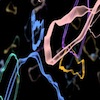string theory
Interalia is a show by Turner Prize winning artist Grenville Davey and theoretical physicist David Berman.
A bizarre set of of 8-dimensional numbers could explain how to handle string-theory's extra dimensions, why elementary particles come in families of three... and maybe even how spacetime emerges in four dimensions.
String theory has one very unique consequence that no other theory of physics before has had: it predicts the number of dimensions of space-time. But where are these other dimensions hiding and will we ever observe them?
On the face of it, an artist and a theoretical physicist might seem an unlikely pairing. But Turner Prize-winning sculptor Grenville Davey and string theorist David Berman's collaboration is producing beautiful, thought-provoking work inspired by the fundamental structure of the Universe. Julia Hawkins interviewed them to find out more about how the Higgs boson and T-duality are giving rise to art.
The holy grail for 21st century physics is to produce a unified theory of everything that can describe the world at every level, from the tiniest particles to the largest galaxies. Currently the strongest contender for such a theory is something called M-theory. So what is this supposed mother of all theories all about?
This is an excerpt from Stephen Hawking's address to his 70th birthday symposium which took place on 8th January 2011 in Cambridge.
It's been nearly 18 months since the Large Hadron Collider at CERN started up and scientists are eagerly awaiting their first glimpse into the cosmic mysteries it was designed to explore. But when can we realistically expect the first ground-breaking discoveries to come through? Last week, John Ellis, outgoing leader of the theory division at CERN, addressed an audience of physicists at the University of Cambridge to update them on the current state of play. Plus went along and also managed to catch Ellis for a quick interview.
That geometry should be relevant to physics is no surprise — after all, space is the arena in which physics happens. What is surprising, though, is the extent to which the geometry of space actually determines physics and just how exotic the geometric structure of our Universe appears to be. Plus met up with mathematician Shing-Tung Yau to find out more.

